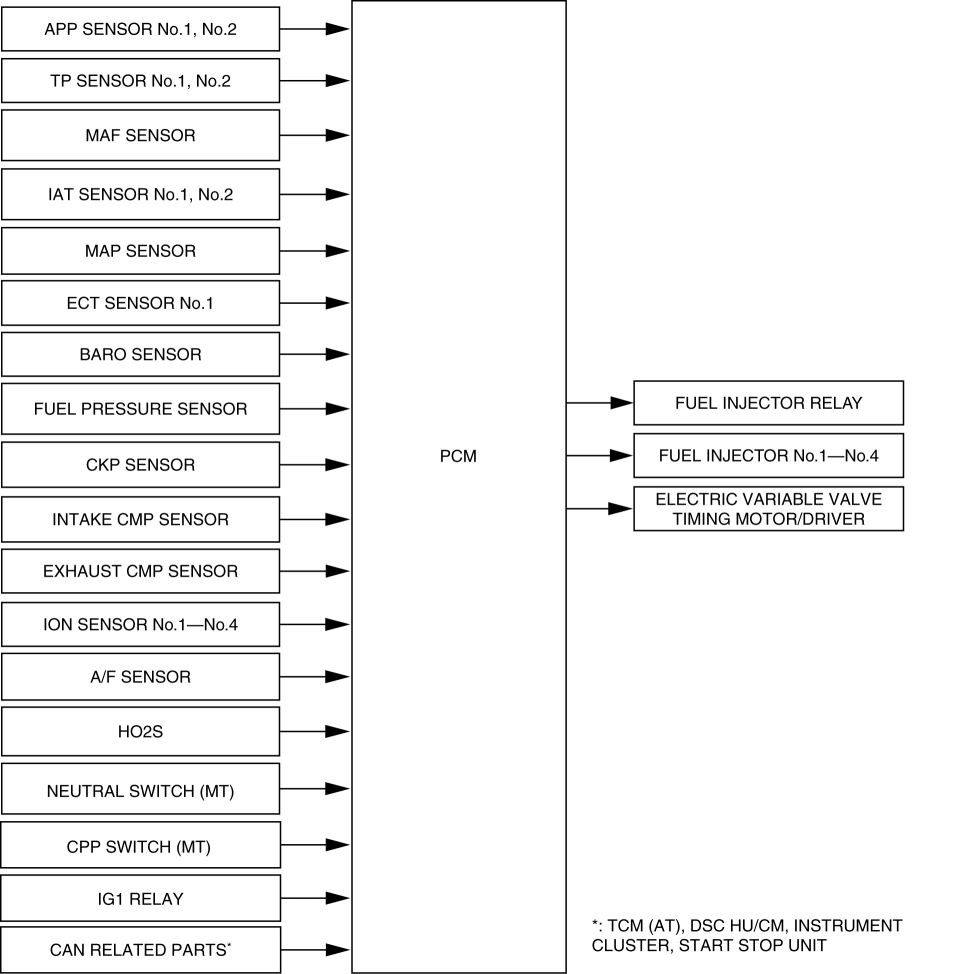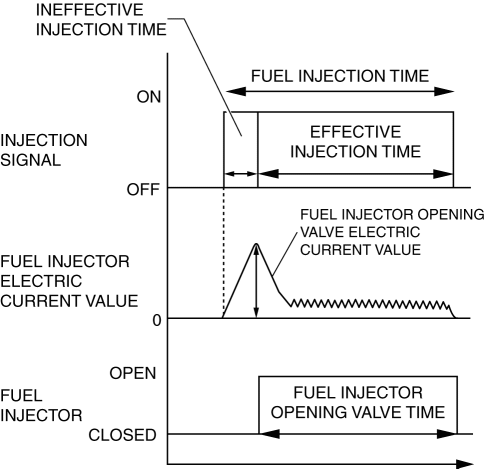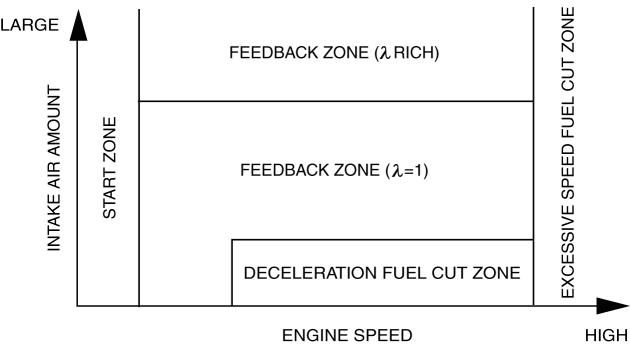FUEL INJECTION CONTROL SYSTEM [SKYACTIV-G 2.0]
Outline
Performs optimum fuel injection according to engine operation conditions.
The PCM determines the engine operation conditions based on the signals from each input device and drives the fuel injectors at the optimal fuel injection time (fuel injection amount) and the fuel injection timing to inject fuel.
Optimally controls combustion based on fuel injection amount, fuel injection timing, number of fuel injections, and the fuel pressure to achieve emission performance improvement and higher engine output.
Block Diagram
Operation
Injection timing
Fuel injection timing is switched according to the engine operation conditions.
Fuel injection is performed at the appropriate injection timing and amount based on the following sensor input signals synchronized with the crankshaft rotation during the intake or compression stroke at each cylinder.
MAF sensor
MAP sensor
IAT sensor No.1
IAT sensor No.2
BARO sensor
CKP sensor
ECT sensor No.1
Injection time
The PCM calculates the fuel injection amount according to the engine operation conditions as the fuel injection time and energizes the fuel injectors.
Fuel injector energization time and operation conditions
The fuel injectors cause an operation delay with the start of energization from the PCM. The PCM calculates the fuel injection time by adding the non-injection time (ineffective injection time) due to the operation delay to the actual injection time (effective injection time), and energizes the fuel injectors for this time.
The fuel injection time is based on the following formula:
Fuel injection time = effective injection time + ineffective injection time
Ineffective injection time
The fuel injectors cause an operation delay with the start of energization due to a delay in the rise of operation current by coil inductance, mass of the needle valve and plunger, and spring resistance. This delay is the ineffective injection time.
The non-injection time is affected by the change in fuel pressure and the battery voltage. Accordingly, the PCM sets the non-injection time according to the fuel pressure and the battery voltage.
Effective injection time
The time when the fuel injector valve is open, which is the actual fuel injection time, is called the effective injection time.
Determination of effective injection time
Control zone table
| Control name |
Control outline |
| Start zone |
|
| Feedback zone (λ = 1) |
|
| Feedback zone (λ rich) |
|
|
|
| Excessive speed fuel cut zone |
|
| Deceleration fuel cut zone |
|
Fuel injection time calculation method table
(A: Fuel injection time base, B: Correction for fuel injection time)| Contents (Calculation or determination method for fuel injection time and correction) |
Control zone |
||||||
| Start zone |
Feedback zone (λ = 1) |
Feedback zone (λ rich) |
Excessive speed fuel cut zone |
Deceleration fuel cut zone |
|||
| Ineffective injection time |
Set time according to fuel injector performance |
A |
A |
A |
|
|
|
| Effective injection time |
Injection time at engine start |
Set value according to engine coolant temperature (low engine coolant temperature→long injection time) |
A |
|
|
|
|
| Basic injection time |
Basic injection time = charging efficiency*1 × fuel flow coefficient*2 |
|
A |
A |
|
|
|
| Fuel cut |
Fuel injection time = 0 |
|
|
|
A |
A |
|
| Correction |
Volume increase correction at engine start |
Purpose: Ensures engine speed stability just after engine start
|
B |
B |
|
|
|
| Feedback correction (A/F sensor) |
Purpose: Controls air/fuel ratio to theoretical air/fuel ratio
|
|
B |
B |
|
|
|
| Feedback correction (HO2S) |
Purpose: Controls air/fuel ratio to theoretical air/fuel ratio
|
|
B |
|
|
|
|
| Warm-up volume increase correction |
Purpose: Ensures combustion stability when engine coolant temperature is low
|
|
B |
B |
|
|
|
| Learning correction |
Purpose: Corrects deviation in air/fuel ratio from deterioration over time of mechanical devices
|
|
B |
B |
|
|
|
| Heavy load volume increase correction |
Purpose: Improved engine output, decrease of exhaust gas temperature
|
|
|
B |
|
|
|
- *1
- Charging efficiency is the ratio of the actual amount of intake air to the maximum air charging amount (mass volume) of the cylinder. The value increases as the engine load increases.
- *2
- Fuel flow coefficient is a coefficient to calculate a fuel injection time from a fuel injection amount required for an intake air amount.
Fuel cut
Fuel cut table
Includes fuel cut under the following conditions, except fuel cut at excessive engine speed and deceleration fuel cut according to engine operation.
| Control name |
Control outline |
| Fuel cut during selector lever shifting in D position (AT) |
|
| Sensor malfunction fuel cut |
|
| Dechoke control |
|
| Theft prevention |
|
| Fuel-cut at time of collision |
|
Boost circuit
The battery positive voltage input via the fuel injector relay is boosted up to 40 V.
Output circuit
To improve fuel injection response, the plunger pulling force is strengthened by providing high current (over excitation current) when the fuel injector is open.
To reduce fuel injector heat generation, the opening of the fuel injector is kept open using low current after it opens.
| Fuel injector status |
PCM operation |
| Opening starts |
|
| Opening held |
|
| Closing |
|


